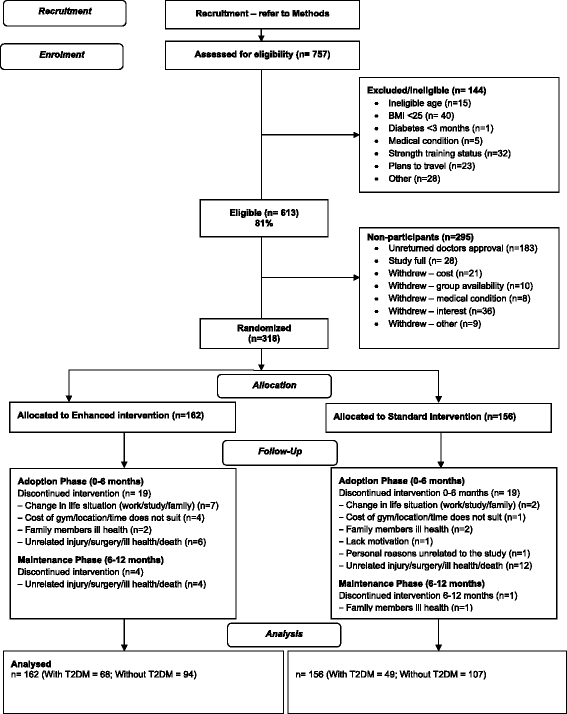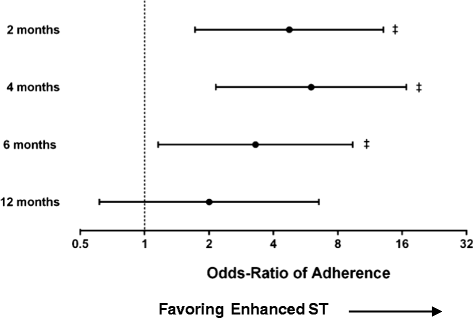Adoption and maintenance of gym-based strength training in the community setting in adults with excess weight or type 2 diabetes: a randomized controlled trial
- PMID: 26303505
- PMCID: PMC4549007
- DOI: 10.1186/s12966-015-0266-5
Adoption and maintenance of gym-based strength training in the community setting in adults with excess weight or type 2 diabetes: a randomized controlled trial
Abstract
Background: Participant adoption and maintenance is a major challenge in strength training (ST) programs in the community-setting. In adults who were overweight or with type 2 diabetes (T2DM), the aim of this study was to compare the effectiveness of a standard ST program (SST) to an enhanced program (EST) on the adoption and maintenance of ST and cardio-metabolic risk factors and muscle strength.
Methods: A 12-month cluster-randomized controlled trial consisting of a 6-month adoption phase followed by a 6-month maintenance phase. In 2008-2009, men and women aged 40-75 years (n = 318) with T2DM (n = 117) or a BMI >25 (n = 201) who had not participated in ST previously were randomized into either a SST or an EST program (which included additional motivationally-tailored behavioral counselling). Adoption and maintenance were defined as undertaking ≥ 3 weekly gym-based exercise sessions during the first 6-months and from 6-12 months respectively and were assessed using a modified version of the CHAMPS (Community Healthy Activity Models Program for Seniors) instrument.
Results: Relative to the SST group, the adjusted odds ratio (OR) of adopting ST for all participants in the EST group was 3.3 (95 % CI 1.2 to 9.4). In stratified analyses including only those with T2DM, relative to the SST group, the adjusted OR of adopting ST in the EST group was 8.2 (95 % CI 1.5-45.5). No significant between-group differences were observed for maintenance of ST in either pooled or stratified analyses. In those with T2DM, there was a significant reduction in HbA1c in the EST compared to SST group during the adoption phase (net difference, -0.13 % [-0.26 to -0.01]), which persisted after 12-months (-0.17 % [-0.3 to -0.05]).
Conclusions: A behaviorally-focused community-based EST intervention was more effective than a SST program for the adoption of ST in adults with excess weight or T2DM and led to greater improvements in glycemic control in those with T2DM.
Trial registration: Registered at ACTRN12611000695909 (Date registered 7/7/2011).
Figures
References
-
- Smutok MA, Reece C, Kokkinos PF, Farmer C, Dawson P, Shulman R, DeVane-Bell J, Patterson J, Charabogos C, Goldberg AP, et al. Aerobic versus strength training for risk factor intervention in middle-aged men at high risk for coronary heart disease. Metabolism. 1993;42(2):177–84. doi: 10.1016/0026-0495(93)90032-J. - DOI - PubMed
-
- Colberg SR, Albright AL, Blissmer BJ, Braun B, Chasan-Taber L, Fernhall B, Regensteiner JG, Rubin RR, Sigal RJ. Exercise and type 2 diabetes: american college of sports medicine and the american diabetes association: joint position statement. Exercise and type 2 diabetes. Med Sci Sports Exerc. 2010;42(12):2282–303. doi: 10.1249/MSS.0b013e3181eeb61c. - DOI - PubMed
-
- Australian Bureau of Statistics . Physical activity in Australia: a snapshot, 2007–08 volume Cat no: 4835.0.55.001. Canberra: Australian Bureau of Statistics; 2011.
Publication types
MeSH terms
Substances
LinkOut - more resources
Full Text Sources
Other Literature Sources
Medical
Research Materials



